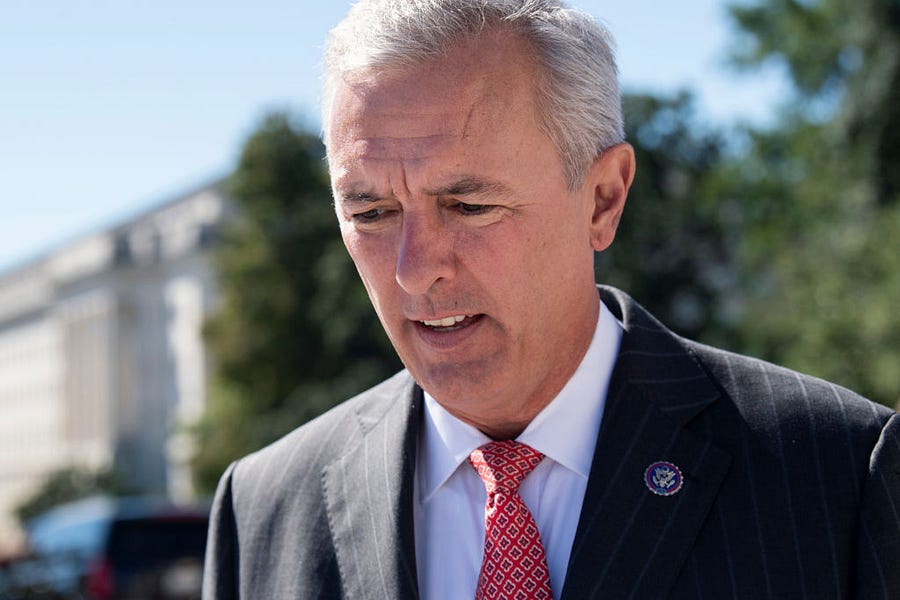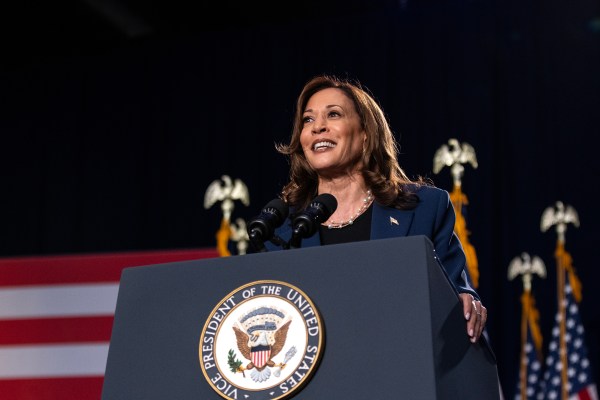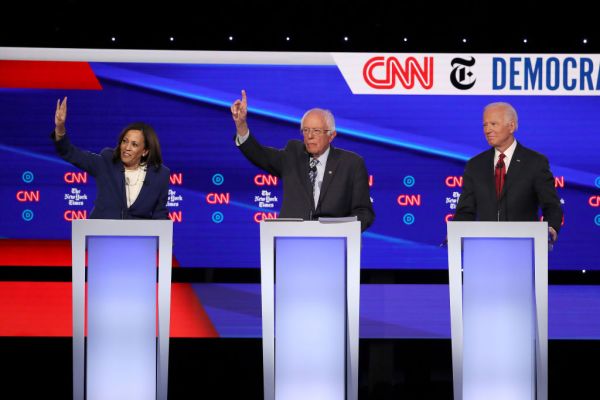Stephanie Murphy’s narrow defeat of 12-term GOP incumbent Rep. John Mica in 2016 quickly transformed her into a rising star within the Democratic Party. Even though a 2015 court-ordered redistricting ruling tilted Florida’s 7th Congressional District in her favor that election cycle, Murphy still only managed to carry 51.5 percent of the vote, setting herself up for a first term in Congress serving a constituency with little patience for ultra-progressive governing.
Murphy internalized the dynamics of her district, joining the bipartisan Problem Solvers Caucus and becoming co-chair of the Blue Dog Coalition—a caucus of self-defined moderates who represent “the commonsense, moderate voice of the Democratic Party.” And she soon had a record to show for it. By the end of the Trump administration, her FiveThirtyEight Trump score—a metric that measured how often a lawmaker voted with the former president—clocked in at 30.5 percent, reflecting her willingness to buck party lines for her moderate constituents. By comparison, Democratic Speaker of the House Nancy Pelosi and Majority Leader Steny Hoyer ended the last administration with Trump scores of 17.6 percent and 12.8 percent, respectively.
But Murphy’s bipartisan star power crashed to a halt last month when the three-term Democrat announced she will not seek reelection.
Even though Florida’s new redistricting maps likely influenced Murphy’s decision to leave Congress, her retirement speaks to a broader trend of Democrats fleeing the lower chamber ahead of the midterms, when House Republicans are expected to retake the majority this fall.
For now, 29 Democrats have announced they won’t seek reelection to the House after this term, with eight seeking another office. Only 14 House Republicans are calling it quits, seven of whom are running for another office.
Retiring Democratic members are keenly aware that high inflation, President Joe Biden’s lagging approval numbers, and the White House’s failure to follow through on its legislative promises make this year’s political environment inhospitable to Democrats, particularly those who represent battleground districts. Many others, like Jim Cooper—another Blue Dog Democrat from Tennessee—have seen their reelection prospects dwindle as a result of new redistricting maps.
Many members from bluer districts are also calling it quits ahead of November, perhaps propelled by the grim prospect of staying in Congress while in the minority. “If you have a gavel, you don’t want to lose the gavel,” said centrist GOP Rep. Don Bacon, member of the Problem Solvers Caucus and co-chair of the Main Street Caucus. “[Democrats] are anticipating significant losses based on the polling, so I think that’s what’s driving a lot of it.”
But there’s another part of the retirement equation: The number of centrist members from both sides of the aisle is dwindling at a rapid pace, which increases polarization and decreases the likelihood of compromise on bipartisan issues.
Per data compiled by the Brookings Institute, the number of House members who carried districts won by a presidential candidate from the other party—known as “crossover districts”—averaged well over 100 members for the 40-year period beginning in 1956. That number has shrunk every presidential election cycle since 1984, when 190 members—or 43.7 percent of the House’s 435 members—were elected in crossover districts. In 2020, that number fell to 16—just 4 percent of the entire lower chamber, per FiveThirtyEight’s Geoffrey Skelley.
Democrats have experienced the trend more over the past two decades. “As recently as 2008, there were almost 50 Democrats who won the districts that John McCain carried for president,” said Sabato’s Crystal Ball election analyst Kyle Kondik, down from 86 in 2000. “In this most recent election, there were only seven [crossover Democrats]. Redistricting will sort of shuffle those numbers a little bit, but you’re just seeing a decline really on both sides of members being able to hold these districts that aren’t otherwise favorable to their party.”
Increased polarization among voters from both parties has also exerted downward pressure on moderates to either abandon their bipartisan instincts or leave Congress entirely rather than risk tough reelection battles come midterm season.
Most crossover incumbents insist a tough primary or general election does not faze them. “I know a lot of centrists who are remaining, and that we hope to get reelected,” said Bacon, a Nebraska Republican who won reelection in 2020 by 4.6 points in a district Biden carried by 6.5 points.
There’s also Democratic Rep. Jared Golden of Maine—who won reelection in 2020 by 6.1 points in a district former President Donald Trump carried by 7.4 points. He was the only House Democrat to vote against both the $1.9 trillion COVID relief package in March 2021 and the House version of Biden’s Build Back Better bill eight months later. He was also the only member of Congress to split his vote against on the two articles of impeachment levied against Trump during his first impeachment trial—he voted to impeach on one article but against on the other
But two other members representing crossover districts—Democratic Rep. Cheri Bustos of Illinois and GOP Rep. John Katko of New York—have already bowed out ahead of the November midterms despite being considered rising stars by their colleagues. Bustos won reelection by 4.1 points in a district Trump carried by 1.6 and previously served as Democratic Congressional Campaign Committee chair, while Katko won reelection by 10.2 points in a district Biden carried by 9.1 points in 2020 and is the ranking Republican on the House Homeland Security Committee.
But even their demonstrated leadership experience and ability to win crossover districts have not insulated them from mounting polarization. Katko, for example, was one of 13 House Republicans who broke party ranks in November and voted in favor of Biden’s $1.2 trillion bipartisan infrastructure package.
Even though 19 Senate Republicans voted in favor of the bill just months before, their support of the bill infuriated the far-right flank of the House GOP conference. Rep. Marjorie Taylor Greene posted all 13 pro-infrastructure Republicans’ office numbers on her since-deleted Twitter account and suggested Katko should be stripped of his committee assignments.
“[Katko’s] a great talent that the House is losing—someone who is honest and courageous,” retiring Democratic Rep. Jackie Speier of California said in a brief interview on Monday.
Katko’s retirement comes as Trump is trying to purge the House GOP conference of any pro-impeachment and pro-infrastructure members. So far, Katko is one of three pro-impeachment House Republicans—including GOP Reps. Anthony Gonzalez of Ohio and Adam Kinzinger of Illinois—who are not seeking reelection this fall.
But Trump’s strategy seems to be ruffling feathers in even the most reliably red districts. Retiring GOP Rep. Kevin Brady, who carried nearly 73 percent of the vote in Texas’ 8th Congressional District in 2020, acknowledged that Republicans could do more to lend support to members of their conference who represent competitive districts. “For Republicans, we should always remember that we have to represent our districts, and some of our districts are just far more moderate than a conservative district like mine,” Brady told The Dispatch last week.
The same goes for centrist House Democrats like Murphy, who was instrumental in calling for a standalone House vote on Biden’s $1.2 trillion infrastructure bill in November, despite pressure from House Democratic leaders—and members of the Progressive Caucus—to vote on the bill in conjunction with Biden’s multi-trillion-dollar Build Back Better Act.
“I feel like I have an obligation to reflect the voices of districts that don’t look like the majority of our caucus,” Murphy told Politico in early November. “Oftentimes decisions are made, and they don’t take into account what a purple or red or marginal blue seat looks like.”
Centrist retirements are welcome news to some progressive lawmakers, who often view moderates like Murphy as obstacles standing in the way of Biden’s tax-and-spend agenda. “I think on the Democratic side, when you see dozens of retirements, we are presented with an opportunity to remake Congress and the makeup of it in a way that is more reflective of the issues of our time,” Democratic Rep. Mondaire Jones told The Dispatch Monday. “I can’t think of a successor to any retiring member of Congress who’s not more progressive than [their predecessor].”
While Democrats in the Senate are more insulated often from the more rapid polarization taking shape in the House, moderate senators face increasing pressure to fall into line with the party.
Take centrist Democratic Sens. Joe Manchin and Kyrsten Sinema, who torpedoed Senate Majority Leader Chuck Schumer’s latest attempts to pass Build Back Better and amend the filibuster to advance two voting rights bills to Biden’s desk. Their opposition to both party-line votes provoked so much ire from their Democratic colleagues that Vermont Sen. Bernie Sanders said he’d be open to supporting primary challengers in their races in 2024.
But senators—even those regularly shamed by party leaders—have the buffer of a six-year term. House lawmakers who buck their party don’t have that luxury. In an interview last week, Katko—who insists he is retiring for “strictly personal reasons”—told The Dispatch he has become increasingly disillusioned with the extremist flanks of both parties: “Without moderates, this place will be almost unworkable.”










Please note that we at The Dispatch hold ourselves, our work, and our commenters to a higher standard than other places on the internet. We welcome comments that foster genuine debate or discussion—including comments critical of us or our work—but responses that include ad hominem attacks on fellow Dispatch members or are intended to stoke fear and anger may be moderated.